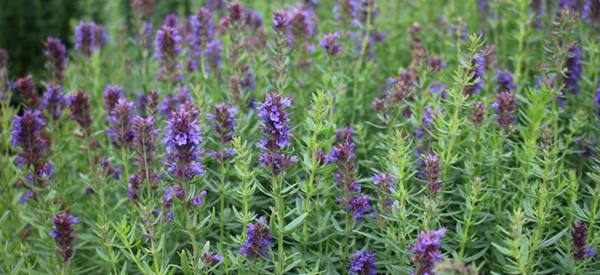
Hyssop
Hyssop (Hyssopus officinalis) is a semi-evergreen herb of the mint family used for flavoring French liqueurs. Its pollen is used in manufacturing aromatic honey. Hyssop is also a source of an essential oil revered in biblical times. The name means holy herb from the Hebrew word Azob or Aesob. Folk tradition believes in the ability of hyssop in purifying homes and keeping out negativity. Thus, people used to hang the dried plants in their homes to protect them from plagues. It is also planted in graves believing that it can protect the dead.
The common hyssop, along with other aromatic herbs, has many references in the Bible since they are used for cleansing the sinful. The plant is native to Southern Europe and reached the United States through the European colonists. Nowadays, hyssop is widely used as an ornamental, medicinal, and culinary herb in many places where it is cultivated.
Where Hyssop Is Found
Hyssop was endemic to Europe and Central Asia before it was naturalized in the United States. They are now scattered in many places all over the world. They often grow in wastelands and roadsides, and even in coastal locations. Beekeepers cultivate hyssop to attract bees and produce aromatic honey.
⇒ The Complete Map of Edible Plants: Find Out What You Have in Your Area! (Video)
How To Identify Hyssop
Hyssop serves as a decorative plant in many gardens and is often used as a low hedge. Its bushy and clumping growth adds an aesthetic appeal to many decorative gardens. It also grows pretty purple flowers that emit a sweet scent and attract pollinators.
- Leaves. Hyssop leaves produce a strong minty odor. They are green, shiny, and simple; arranged in pairs opposite each other on the stem.
 Each lance-shaped leaf measures about one to three inches long and is attached directly to the base without a stalk.
Each lance-shaped leaf measures about one to three inches long and is attached directly to the base without a stalk.
- Flowers. Hyssop blooms are arranged in whorls of six to fifteen flowers. It has a tubular corolla with two prominent lips with hairs in the inner petal. Hyssop flowers are showy and bloom during summer.
- Fruits and Seeds. When hyssop flowers mature, they will develop into dry oblong fruit or achene. An achene is a type of dry fruit that does not split open when ripe. Each fruit measures about 2.5 mm long and can contain one to four brown seeds.
- Roots. Hyssop has a large and fibrous taproot system. The roots do spread, but are not as aggressive as other plants of the mint family.
- Stem. Hyssop is a small perennial that can grow to only about 20 to 80 cm tall. It has a woody base, with slim and also woody angular stems. It is multi-branching, but the stems are erect and not tangled.
⇒ Plant Identification Guide – 400 Wild Plants That You Can Forage For (Video)
Hyssopus officinalis is a member of the Lamiaceae or mint family. It is also called the Common Hyssop, garden hyssop, Curdukotu, Yssop, Ysopo, Hyssop Herb, or yanagi-hakka. The plant has four varieties that are easily distinguishable by the color of their flowers.
- Hyssopus alba with white flowers
- Hyssopus rubra bears red flowers
- Hyssopus rosea has pink flowers
- Hyssopus grandiflora has large and bluish to purple flowers
How To Grow Hyssop
Hyssop can grow in many locations, but they thrive best in places where they can get partial sun. The plant can propagate through root division, cutting, or seeds. If you prefer to grow hyssop from seeds, you may find many varieties in online stores. However, they have slow germination, so you need to be patient with them.
It may take about two to four weeks for the hyssop seeds to germinate. But, planting them is straightforward and you can even sow them directly in the garden. Hyssop is also a slow spreader. They can spread through their roots, but they will not overwhelm your garden.
You can plant them in containers. However, hyssop is more attractive when grown in masses. They are great for edging and borders and flourish with other companion plants.
Growing Hyssop from Seeds
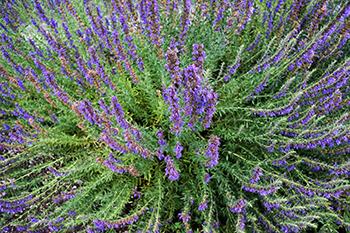 Hyssop is commonly cultivated through seeds either indoors or directly in the garden. You can sow hyssop seeds eight to ten weeks before the last frost.
Hyssop is commonly cultivated through seeds either indoors or directly in the garden. You can sow hyssop seeds eight to ten weeks before the last frost.
Plant the seeds in deep pots about ¼ inch deep into the soil and cover them lightly. If sowing them indoors, transplant the seedlings only after the danger of the frost has passed.
Space the plants about 6 to 12 inches apart to give their roots ample room to grow.
Growing Hyssop from Cuttings
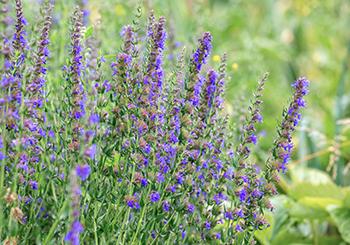
Propagate hyssop plants through their cuttings in late spring or early fall.
Take a six-inch cutting from a healthy plant and strip off the lower leaves.
Stick the end into moist sand and occasionally mist it.
The sand should remain slightly moist, but not wet, until the roots develop in about a month.
Growing Hyssop from Root Stock Division
If you want to grow a new hyssop plant, you can divide the roots of matured hyssop plant in spring. Dig the plant preferably early in the morning, and divide its fibrous roots into three pieces. You can choose to replant the parent hyssop plant. Meanwhile, loosen the soil from the divided roots and plant them in holes of their size. Backfill the holes with garden soil, making sure that the plants are not set too deep.
⇒ Stopped Spending Money At The Pharmacy By Growing These 10 Plants (Video)
Plant Care and Maintenance
Hyssop is hardy and can adapt well in USDA Zones 4 to 9. It craves well-draining and fertile loam soil with either full sun or partial shade requirements. Hyssop needs little maintenance, but will particularly grow healthy in the following conducive conditions:
- Dry and well-drained fertile soil
- Full sun or partial shade
- Rotted compost and organic materials
- Watering only when the soil is dry
- Pruning when the plant gets too crowded
Hyssop can be pest and disease-resistant because of its strong minty scent. It can repel flea beetle and cabbage moths and is also elk and deer resistant.
However, it is not immune to other pathogens and diseases like root rot, powdery mildew, and rust. You can easily ameliorate it by transferring hyssop to well-draining soil and avoiding overwatering it. You can get rid of rust with any copper or sulfur-based spray.
⇒ How to Make A Self-Sufficient Backyard on 1/4 of an Acre (Video)
How To Harvest Hyssop
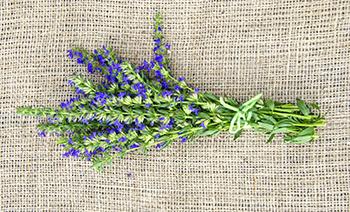 Hyssop has a potent bitter taste by the time it is about to bloom. It is the ideal time to harvest if you want to use it for culinary or medicinal purposes.
Hyssop has a potent bitter taste by the time it is about to bloom. It is the ideal time to harvest if you want to use it for culinary or medicinal purposes.
Cut a sprig in the morning after the dew has dried out.
The flowers are best harvested while they are still fresh and colorful.
To dry the hyssop cuttings, tie them in small bundles. Hang it in a dark, dry and well-ventilated room. When it is thoroughly dry, gather the leaves and store them whole in a plastic bag. You can crush or dry them only before use.
You may also store fresh hyssop in a container bag. Fresh hyssop will only last for a few days. Dried hyssop can preserve well for up to 18 months when stored in an airtight container.
What Hyssop Is Good For And Natural Remedies Made From It
In the Bible, you can find the line “Purge me with hyssop, and I shall be clean; wash me, and I shall be whiter than snow” in verse 7 of Psalm 51.
It referenced the biblical use of hyssop in cleansing and purification. The Romans used hyssop in warding off plagues by hanging them in their homes.
In modern medicine, hyssop has many ayurvedic uses.
Dried hyssop is used for treating gastrointestinal complaints like stomach ache, flatulence, indigestion, and acid reflux. It can also cure Ascaris infection and cleanse the stomach from other intestinal parasites.
Hyssop is an antibiotic and expectorant, making it an effective natural treatment for cough. For many years, it has been used for treating bronchitis and other illnesses of the respiratory tract. Hyssop can soothe the throat and offers plenty of benefits for people who work using their voices. Thus, it is a valuable herb for most teachers, lecturers, and singers, among others. If you still have coughing problems after using hyssop, you can also try this remedy.
Hyssop’s antiseptic and antibiotic properties treat deep wounds, insect bites, and other skin-related problems. An infusion of hyssop is used as wound wash to promote prompt healing and prevent infections. Hyssop poultice is also used in bruises, scars, frostbite, and conjunctivitis.
In old-fashioned remedies, hyssop tea is taken to alleviate rheumatism. It is then supplemented with a hyssop bath to relieve its symptoms. Hyssop regulates the skeletal system and maintains the level of synovial fluid, preventing many bone-related diseases.
Tincture and tea made of hyssop leaves can cure jaundice and edema. Hot vapors emanating from hyssop decoction may also treat ear inflammations.
In summary, hyssop can cure these common ailments:
- Abdominal and digestive problems
- Respiratory illnesses

- Wound and skin problems
- Bone, joint, and muscle pain
- Mouth, throat, and dental issues
- Menstrual problems (you can also try sage)
- Ear and eye problems
- Fever, flu, cold (you can also try this DIY tincture for fever)
- Hypotension
- Intestinal worms
- HIV/AIDS
What Parts Of Hyssop Are Used For Remedies?
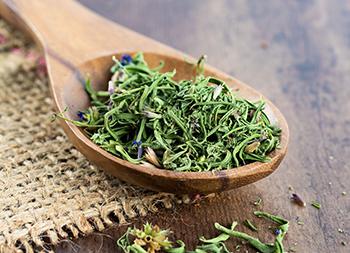 The flowers, leaves, shoots, and stalk of hyssop are used for different medicinal preparations. Its roots and barks are also used, but not as common as its aerial parts. Hyssop flowers and leaves have a high concentration of volatile oil extracted for essential oil.
The flowers, leaves, shoots, and stalk of hyssop are used for different medicinal preparations. Its roots and barks are also used, but not as common as its aerial parts. Hyssop flowers and leaves have a high concentration of volatile oil extracted for essential oil.
Hyssop is used fresh or dried for making medicinal tea, decoction, infusion, or concoction.
The most popular and widely used preparation of this herb is essential oil. It can be applied topically or internally with a carrier oil. It is also added to bath water to stimulate sweating or lower the body temperature during fever. You may further use hyssop in aromatherapy by adding a few drops of its oil to the diffuser.
Hyssop Poultice for Cuts and Wounds
Ingredients:
- Fresh or dried hyssop leaves and flowers
- A small amount of boiling water
- Muslin or cheesecloth
- Medical tape or cotton wrap
Steps:
- Soak the dried herb in boiling water, just enough to make a paste, for 15 minutes and apply it warm. If you are using fresh herbs, simply bruise or crush the leaves before application.

- Spread the hyssop paste into the affected area.

- Cover with a cheesecloth or muslin. Then, secure with a tape or cotton cloth wide enough to tie around the area.

- Refresh the poultice by replacing the mixture as often as needed.
How to use this remedy:
Poultices work best for taming inflammation caused by wounds and cuts (you can also use chaparral salve for this). Hyssop poultice promotes faster healing of wounds and wards of potential infection. Make sure to wash the affected area and use only a clean cloth.
There is no standard dosing for hyssop supplements, so just follow the instructions on product labels. But, the typical dosage for hyssop tea is 2 grams of the herb, taken three times a day. Hyssop oil should not be taken for more than 30 drops a day.
Warnings And Cautions
Hyssop is safe when used in food amounts and is likely safe when used as medicine.
The herb is not intended for use by pregnant women as it is an emmenagogue that can cause miscarriage. There is no evidence of hyssop safety when used by breastfeeding mothers. So, it is safe to avoid its use.
Hyssop is likewise unsafe for use in children.
Hyssop is a convulsant that may trigger spasm and convulsions. Thus, it is not safe for people with epilepsy and seizure problems. High doses and long-term use of hyssop can also result in a seizure.
Do not use hyssop oil if using other hyssop herbal preparations for internal use.
People with allergies to mint or deadnettle families should avoid using hyssop medicinally.
If you have hypertension, do not use hyssop supplements and herbal products as the herb is known to raise blood pressure levels.
In using any herbal products, consult a doctor for its proper dosage and understand its benefits and complications.
You may also like:
 God’s Pharmacy: 10 Medicinal Plants from the Bible
God’s Pharmacy: 10 Medicinal Plants from the Bible
A Simple “At-Home” Protocol for the Flu and Other Respiratory Issues (Video)
My #1 Go-To Herb for Avoiding Influenza, Colds, and Severe Respiratory Illness








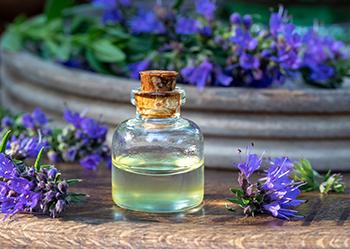
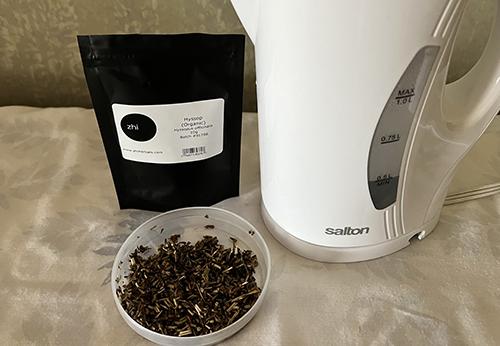
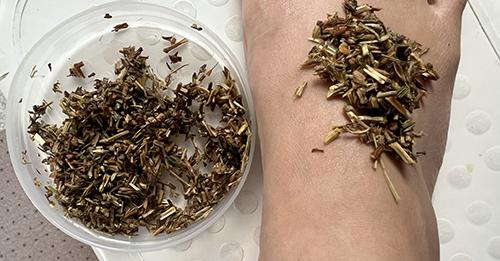

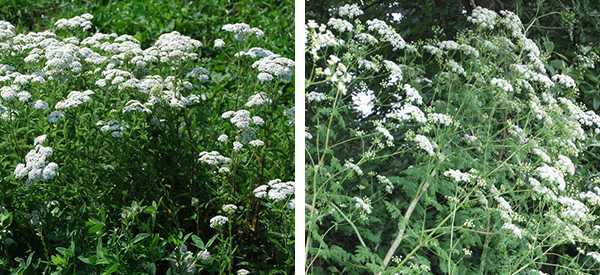


What is the best way to use hyssop for gastrointestinal issues? My son has Crohn’s and I’d like to see if hyssop would help reduce the inflammation.
Hi Tanya,
Hyssop helps regulate your digestive system and supports the immune system. It can be taken in many forms, the easiest being the tea.
To make your own hyssop tea, follow these directions.
Start by boiling two cups of water.
Add two tablespoons of fresh hyssop leaves to the water
Let it steep for 30 minutes.
You can make your own tincture as well. Traditionally taken: 1 – 4ml tincture 3 times per day, or as directed by a Herbal Practitioner. The appropriate dose of hyssop depends on several factors such as the user’s age, health, and several other conditions.
Many blessings and good health!
You need Wild Blue Lettuce…right now it’s beginning to seed out, but if you collect the leaves, & dry, for the winter & collect the feathery seeds, to grow yourself. I have a plant identifier, & ulcerative colitis…I freely eat the leaves during summer, & dampen a paper towel & microwave for 30 seconds…
They make DOXYCYCLINE, antibiotic from it.
I had/have chrohn’s and beat back all the signs and symptoms by cutting out all oil and fried foods. Gone from my diet. I carefully added olive oil and coconut oil because of their medicinal value, but no fries or chips.
I mistakenly planted Anise Hyssop thinking it the same as regular Hyssop.
Does Anise Hyssop have any medicinal uses?
It is good for colds and respiratory infections.